Yōkai
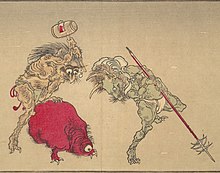
| Part of the series on |
| Japanese mythology and folklore |
|---|
 |
| Mythic texts |
|
| Divinities |
|
| Legendary creatures and urban legends |
| Mythical and sacred locations |
| Sacred objects |
|
| Shintō and Buddhism |
|
Yōkai (妖怪, "strange apparition") are a class of supernatural entities and spirits in Japanese folklore. The word 'yōkai' is composed of the kanji for "attractive; calamity" and "apparition; mystery; suspicious."[1][2] Yōkai are also referred to as ayakashi (あやかし), mononoke (物の怪) or mamono (魔物). Yokai are not literally demons in the Western sense of the word, but are instead spirits and entities, whose behaviour can range from malevolent or mischievous to friendly, fortuitous, or helpful to humans. The nearest or equivalent definition for yōkai in Western world should be "spectre/specter".
Yōkai often have animal features (such as the kappa, depicted as appearing similar to a turtle, and the tengu, commonly depicted with wings), but may also appear humanoid in appearance, such as the kuchisake-onna. Some yōkai resemble inanimate objects (such as the tsukumogami), while others have no discernible shape. Yōkai are typically described as having spiritual or supernatural abilities, with shapeshifting being the most common trait associated with them. Yōkai that shapeshift are known as bakemono (化け物) or obake (お化け).
Japanese folklorists and historians explain yōkai as personifications of "supernatural or unaccountable phenomena to their informants." In the Edo period, many artists, such as Toriyama Sekien, invented new yōkai by taking inspiration from folk tales or purely from their own imagination. Today, several such yōkai (such as the amikiri) are mistaken to originate in more traditional folklore.[3]
Concept[]
The concept of yōkai, their causes and phenomena related to them varies greatly throughout Japanese culture and historical periods; typically, the older the time period, the higher the number of phenomena deemed to be supernatural and the result of yōkai.[4] According to Japanese ideas of animism, spirit-like entities were believed to reside in all things, including natural phenomena and objects.[5] Such spirits possessed emotions and personalities: peaceful spirits were known as nigi-mitama, who brought good fortune; violent spirits, known as ara-mitama, brought ill fortune, such as illness and natural disasters. Neither type of spirit was considered to be yōkai.
One's ancestors and particularly respected departed elders could also be deemed to be nigi-mitama, accruing status as protective spirits who brought fortune to those who worshipped them. Animals, objects and natural features or phenomena were also venerated as nigi-mitama or propitiated as ara-mitama depending on the area.
Despite the existence of harmful spirits, rituals for converting ara-mitama into nigi-mitama were performed, aiming to quell maleficent spirits, prevent misfortune and alleviate the fear arising from phenomena and events that otherwise had no explanation.[6] The ritual for converting ara-mitama into nigi-mitama was known as the (鎮魂) (lit., "the calming of the spirits" or a "Requiem").[7] Chinkon rituals for ara-mitama that failed to achieve deification as benevolent spirits, whether through a lack of sufficient veneration or through losing worshippers and thus their divinity, became yōkai.[8]
Over time, phenomena and events thought to be supernatural became fewer and fewer, with the depictions of yōkai in picture scrolls and paintings beginning to standardise, evolving more into caricatures than fearsome spiritual entities. Elements of the tales and legends surrounding yōkai began to be depicted in public entertainment, beginning as early as the Middle Ages in Japan.[9] During and following the Edo period, the mythology and lore of yōkai became more defined and formalised.[10]
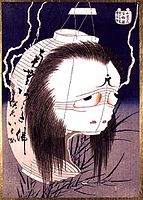
Chōchin-oiwa by Katsushika Hokusai

Kidōmaru by Utagawa Kuniyoshi

Nekomata from the Hyakkai Zukan by
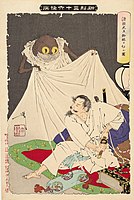
Tsuchigumo from the (新形三十六怪撰) by Tsukioka Yoshitoshi
Gama Yōkai from the Saigama to Ukiyo Soushi Kenkyu Volume 2, special issue Kaii[11]
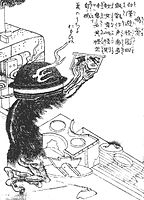
from the Gazu Hyakki Tsurezure Bukuro by Sekien Toriyama
Types[]
The folklorist studied the literature and paintings depicting yōkai and henge (変化) (lit., "changed things/mutants"), dividing them into categories as presented in the Nihon Yōkai Henge Shi and the Obake no Rekishi:
- Categories based on a yōkai's "true form":
- Human
- Animal
- Plant
- Object
- Natural phenomenon
- Categories depending on the source of mutation:
- Mutation related to this world
- Spiritual or mentally related mutation
- Reincarnation or afterworld related mutation
- Material related mutation
- Categories based on external appearance:
- Human
- Animal
- Plant
- Artifact
- Structure or building
- Natural object or phenomenon
- Miscellaneous or appearance compounding more than one category
In other folklorist categorisations, yōkai are classified, similarly to the nymphs of Greek mythology, by their location or the phenomena associated with their manifestation. Yōkai are indexed in the book Sogo Nihon Minzoku Goi (綜合日本民俗語彙, "A Complete Dictionary of Japanese Folklore")[12] as follows:
- Yama no ke (mountains)
- michi no ke (paths)
- ki no ke (trees)
- mizu no ke (water)
- umi no ke (the sea)
- yuki no ke (snow)
- oto no ke (sound)
- dōbutsu no ke (animals, either real or imaginary)
History[]
Ancient history[]
- First century: there is a book from China titled Xúnshǐ zhuàn 循史傳 with the statement "the spectre (yōkai) was in the imperial court for a long time. The king asked Tui for the reason. He answered that there was great anxiety and he gave a recommendation to empty the imperial room" (久之 宮中数有妖恠(妖怪) 王以問遂 遂以為有大憂 宮室将空), thus using "妖恠" to mean "phenomenon that surpasses human knowledge."
- Houki 8 (772): in the Shoku Nihongi, there is the statement "Shinto purification is performed because yōkai appear very often in the imperial court, (大祓、宮中にしきりに、妖怪あるためなり)," using the word "yōkai" to mean not anything in particular, but strange phenomena in general.
- Middle of the Heian era (794–1185/1192): In The Pillow Book by Sei Shōnagon, there is the statement "there are tenacious mononoke (いと執念き御もののけに侍るめり)" as well as a statement by Murasaki Shikibu that "the mononoke have become quite dreadful (御もののけのいみじうこはきなりけり)", which are the first appearances of the word "mononoke".
- Koubu 3 (1370): In the Taiheiki, in the fifth volume, there is the statement, "Sagami no Nyudo was not at all frightened by yōkai."

The ancient times were a period abundant in literature and folktales mentioning and explaining yōkai. Literature such as the Kojiki, the Nihon Shoki, and various Fudoki expositioned on legends from the ancient past, and mentions of oni, orochi, among other kinds of mysterious phenomena can already be seen in them.[13] In the Heian period, collections of stories about yōkai and other supernatural phenomena were published in multiple volumes, starting with publications such as the Nihon Ryōiki and the Konjaku Monogatarishū, and in these publications, mentions of phenomena such as Hyakki Yagyō can be seen.[14] The yōkai that appear in these literature were passed on to later generations.[15] However, despite the literature mentioning and explaining these yōkai, they were never given any visual depictions. In Buddhist paintings such as the Hell Scroll (Nara National Museum), which came from the later Heian period, there are visual expressions of the idea of oni, but actual visual depictions would only come later in the Middle Ages, from the Kamakura period and beyond.[16]
Yamata no Orochi was originally a local god but turned into a yōkai that was slain by Susanoo.[17] Yasaburo was originally a bandit whose vengeful spirit (onryo) turned into a poisonous snake upon death and plagued the water in a paddy, but eventually became deified as the "wisdom god of the well (井の明神)."[18] Kappa and inugami are sometimes treated as gods in one area and yōkai in other areas. From these examples, it can be seen that among Japanese gods, there are some beings that can go from god to yōkai and vice versa.[19]
Post-classical history[]

Medieval Japan was a time period where publications such as Emakimono, Otogizōshi, and other visual depictions of yōkai started to appear. While there were religious publications such as the Jisha Engi (寺社縁起), others, such as the Otogizōshi, were intended more for entertainment, starting the trend where yōkai became more and more seen as subjects of entertainment. For examples, tales of yōkai extermination could be said to be a result of emphasizing the superior status of human society over yōkai.[9] Publications included:
- The Ooe-yama Shuten-doji Emaki (about an oni), the Zegaibou Emaki (about a tengu), the Tawara no Touta Emaki (俵藤太絵巻) (about a giant snake and a centipede), the (土蜘蛛草紙) (about tsuchigumo), and the Dojo-ji Engi Emaki (about a giant snake). These emaki were about yōkai that come from even older times.
- The Kitano Tenjin Engi Emaki, in which Sugawara no Michizane was a lightning god who took on the form of an oni, and despite attacking people after doing this, he was still deified as a god in the end.[9]
- The Junirui Emaki, the Tamamono Soshi, (both about Tamamo-no-Mae), and the Fujibukuro Soushi Emaki (about a monkey). These emaki told of yōkai mutations of animals.
- The , which told tales of thrown away none-too-precious objects that come to have a spirit residing in them planning evil deeds against humans, and ultimately get exorcised and sent to peace.
- The , depicting many different kinds of yōkai all marching together
In this way, yōkai that were mentioned only in writing were given a visual appearance in the Middle Ages. In the Otogizōshi, familiar tales such as Urashima Tarō and Issun-bōshi also appeared.
The next major change in yōkai came after the period of warring states, in the Edo period.
Modern history[]
Edo period[]
- Enpō 6 (1677): Publication of the , a collection of tales of various monsters.
- Hōei 6 (1706): Publication of the Otogi Hyakumonogatari. In volumes such as "Miyazu no Ayakashi" (volume 1) and "Unpin no Yōkai" (volume 4), collections of tales that seem to come from China were adapted into a Japanese setting.[20]
- Shōtoku 2 (1712): Publication of the Wakan Sansai Zue by Terajima Ryōan, a collection of tales based on the Chinese Sancai Tuhui.
- Shōtoku 6 (1716): In the specialized dictionary (世説故事苑), there is an entry on yōkai, which stated, "among the commoners in my society, there are many kinds of kaiji (mysterious phenomena), often mispronounced by commoners as 'kechi.' Types include the cry of weasels, the howling of foxes, the bustling of mice, the rising of the chicken, the cry of the birds, the pooping of the birds on clothing, and sounds similar to voices that come from cauldrons and bottles. These types of things appear in the , methods of exorcising them can be seen, so it should serve as a basis."[21]
- Tenmei 8 (1788): Publication of the Bakemono chakutocho by Masayoshi Kitao. This was a kibyoshi diagram book of yōkai, but it was prefaced with the statement "it can be said that the so-called yōkai in our society is a representation of our feelings that arise from fear" (世にいふようくわいはおくびょうよりおこるわが心をむかふへあらわしてみるといえども ... ),[22] and already in this era, while yōkai were being researched, it indicated that there were people who questioned whether yōkai really existed or not.
It was in this era that the technology of the printing press and publication was first started to be widely used, that a publishing culture developed, and was frequently a subject of kibyoshi[23] and other publications.
As a result, kashi-hon shops that handled such books spread and became widely used, making the general public's impression of each yōkai fixed, spreading throughout all of Japan. For example, before the Edo period, there were plenty of interpretations about what the yōkai were that were classified as kappa, but because of books and publishing, the notion of kappa became anchored to what is now the modern notion of kappa. Also, including other kinds of publications, other than yōkai born from folk legend, there were also many invented yōkai that were created through puns or word plays, and the by Sekien Toriyama is one example of that. Also, when the Hyakumonogatari Kaidankai became popular in the Edo period, it is thought that one reason for the appearance of new yōkai was a demand for entertaining ghost stories about yōkai no one has ever heard of before, resulting in some ō that were simply made up for the purpose of telling an entertaining story, and the kasa-obake and the tōfu-kozō are known examples of these.[24]
They are also frequently depicted in ukiyo-e, and there are artists that have drawn famous yōkai like Utagawa Kuniyoshi, Yoshitoshi, Kawanabe Kyōsai, and Hokusai, and there are also Hyakki Yagyō books made by artists of the Kanō school.
In this period, toys and games like karuta and sugoroku, frequently used yōkai as characters. Thus, with the development of a publishing culture, yōkai depictions that were treasured in temples and shrines were able to become something more familiar to people, and it is thought that this is the reason that even though yōkai were originally things to be feared, they have then become characters that people feel close to.[25]
Meiji period[]
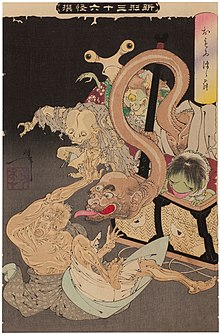
- Meiji 24 (1891): Publication of the Seiyuu Youkai Kidan by . It introduced folktales from Europe, such as the Grimm Tales.
- Meiji 29 (1896): Publication of the Yōkaigaku Kogi by Inoue Enryō
- Meiji 33 (1900): Performance of the kabuki Yami no Ume Hyakumonogatari at the Kabuki-za in January. It was a performance in which appeared numerous yōkai such as the Kasa ippon ashi, skeletons, yuki-onna, osakabe-hime, among others. Onoe Kikugorō V played the role of many of these, such as the osakabe-hime.
- Taishō 3 (1914): Publication of the Shokubutsu Kaiko by Mitsutaro Shirai. Shirai expositioned on plant yōkai from the point of view of a plant pathologist and herbalist.
With the Meiji Restoration, Western ideas and translated western publications began to make an impact, and western tales were particularly sought after. Things like binbogami, , and shinigami were talked about, and shinigami were even depicted in classical rakugo, and although the shinigami were misunderstood as a kind of Japanese yōkai or kami, they actually became well known among the populace through a rakugo called "Shinigami" by San'yūtei Enchō, which were adoptions of European tales such as the Grimm fairy tale "Godfather Death" and the Italian opera Crispino e la comare (1850). Also, in Meiji 41 (1908), Kyōka Izumi and jointedly translated Gerhart Hauptmann's play The Sunken Bell. Later works of Kyōka such as were influenced by The Sunken Bell, and so it can be seen that folktales that come from the West became adapted into Japanese tales of yōkai.
Shōwa period[]
Since yōkai are introduced in various kinds of media, they have become well known among the old, the young, men and women. The kamishibai from before the war, and the manga industry, as well as the kashi-hon shops that continued to exist until around Showa 40 (the 1970s), as well as television contributed to the public knowledge and familiarity with yōkai. Yōkai play a role in attracting tourism revitalizing local regions, like the places depicted in the Tono Monogatari like Tono, Iwate, Iwate Prefecture and the Tottori Prefecture, which is Shigeru Mizuki's place of birth.
In this way, yōkai are spoken about in legends in various forms, but traditional oral storytelling by the elders and the older people is rare, and regionally unique situations and background in oral storytelling are not easily conveyed. For example, the classical yōkai represented by tsukumogami can only be felt as something realistic by living close to nature, such as with tanuki (Japanese raccoon dogs), foxes and weasels. Furthermore, in the suburbs, and other regions, even when living in a primary-sector environment, there are tools that are no longer seen, such as the inkstone, the kama (a large cooking pot), or the tsurube (a bucket used for getting water from a well), and there exist yōkai that are reminiscent of old lifestyles such as the azukiarai and the . As a result, even for those born in the first decade of the Showa period (1925–1935), except for some who were evacuated to the countryside, they would feel that those things that become yōkai are "not familiar" and "not very understandable". For example, in classical rakugo, even though people understand the words and what they refer to, they are not able to imagine it as something that could be realistic. Thus, the modernization of society has had a negative effect on the place of yōkai in classical Japanese culture.
On the other hand, the yōkai introduced through mass media are not limited to only those that come from classical sources like folklore, and just as in the Edo period, new fictional yōkai continue to be invented, such as scary school stories and other urban legends like kuchisake-onna and Hanako-san, giving birth to new yōkai. From 1975 onwards, starting with the popularity of kuchisake-onna, these urban legends began to be referred to in mass media as "modern yōkai".[26] This terminology was also used in recent publications dealing with urban legends,[27] and the researcher on yōkai, , used this especially frequently.[26]
During the 1970s, many books were published that introduced yōkai through encyclopaedias, illustrated reference books, and dictionaries as a part of children's horror books, but along with the yōkai that come from classics like folklore, Kaidan, and essays, it has been pointed out by modern research that there are some mixed in that do not come from classics, but were newly created. Some well-known examples of these are the gashadokuro and the jubokko. For example, is known to be a creator of modern yōkai, and Shigeru Mizuki, a manga artist of yōkai, in writings concerning research about yōkai, pointed out that newly created yōkai do exist,[28][29] and Mizuki himself, through GeGeGe no Kitaro, created about 30 new yōkai.[30] There has been much criticism that this mixing of classical yōkai with newly created yōkai is making light of tradition and legends.[28][29] However, since there have already been those from the Edo period like Sekien Toriyama who created many new yōkai, there is also the opinion that it is unreasonable to criticize modern creations without doing the same for classical creations too.[28] Furthermore, there is a favorable view that says that introducing various yōkai characters through these books nurtured creativity and emotional development of young readers of the time.[29]
In popular culture[]
Yokai is often referred to as a Japanese spirit or an East Asian ghost, like the Hanako-san legend or the story of the "Slit-mouthed girl", both of which hail from Japanese legend. Yokai can also be derived as something strange or unusual.
See also[]
- Dokkaebi – Legendary creature from Korean mythology and folklore
- Kijimunaa – Indigenous Ryukyuan belief system (legendary beings from the Ryukyu Islands)
- List of legendary creatures from Japan – Wikipedia list article of legendary creatures and entities in traditional Japanese mythology
- Yaoguai – Creature from Chinese mythology
- Yōsei
- Yūrei
References[]
- ^ http://jisho.org/kanji/details/%E5%A6%96%E6%80%AA
- ^ http://jisho.org/words?jap=youkai&eng=&dict=edict
- ^ "Toriyama Sekien". Obakemono. The Obakemono Project. Archived from the original on 26 July 2013. Retrieved April 2, 2021.
- ^ 小松和彦 2015, p. 24
- ^ 小松和彦 2011, p. 16
- ^ 宮田登 2002, p. 14、小松和彦 2015, pp. 201–204
- ^ 小松和彦 2011, pp. 16–18
- ^ 宮田登 2002, pp. 12–14、小松和彦 2015, pp. 205–207
- ^ Jump up to: a b c 小松和彦 2011, pp. 21–22
- ^ 小松和彦 2011, pp. 188–189
- ^ 近藤瑞木・佐伯 孝弘 2007
- ^ 民俗学研究所『綜合日本民俗語彙』第5巻 1956年 403–407頁 索引では「霊怪」という部門の中に「霊怪」「妖怪」「憑物」が小部門として存在している。
- ^ 小松和彦 2011, p. 20
- ^ 『今昔物語集』巻14の42「尊勝陀羅尼の験力によりて鬼の難を遁るる事」
- ^ 小松和彦 2011, p. 78
- ^ 小松和彦 2011, p. 21
- ^ 小松和彦 2015, p. 46
- ^ 小松和彦 2015, p. 213
- ^ 宮田登 2002, p. 12、小松和彦 2015, p. 200
- ^ 太刀川清 (1987). 百物語怪談集成. . pp. 365–367.
- ^ "世説故事苑 3巻". 1716. Retrieved 2015-12-16.
- ^ 江戸化物草紙. 校注・編. 小学館. February 1999. p. 29. ISBN 978-4-09-362111-3.CS1 maint: others (link)
- ^ 草双紙 といわれる 絵本 で、ジャンルごとにより表紙が色分けされていた。黄表紙は大人向けのもので、その他に赤や青がある。
- ^ 多田克己 (2008). "『妖怪画本・狂歌百物語』妖怪総覧". In 京極夏彦 ・多田克己編 (ed.). 妖怪画本 狂歌百物語. 国書刊行会. pp. 272–273頁. ISBN 978-4-3360-5055-7.
- ^ 湯本豪一 (2008). "遊びのなかの妖怪". In 講談社コミッククリエイト編 (ed.). DISCOVER妖怪 日本妖怪大百科. KODANSHA Official File Magazine. VOL.10. 講談社. pp. 30–31頁. ISBN 978-4-06-370040-4.
|volume=has extra text (help) - ^ Jump up to: a b 山口敏太郎 (2007). 本当にいる日本の「現代妖怪」図鑑. 笠倉出版社. pp. 9頁. ISBN 978-4-7730-0365-9.
- ^ "都市伝説と妖怪". DISCOVER妖怪 日本妖怪大百科. VOL.10. pp. 2頁.
|volume=has extra text (help) - ^ Jump up to: a b c と学会 (2007). トンデモ本の世界U. 楽工社. pp. 226–231. ISBN 978-4-903063-14-0.
- ^ Jump up to: a b c 妖怪王(山口敏太郎)グループ (2003). 昭和の子供 懐しの妖怪図鑑. コスモブックス. アートブック本の森. pp. 16–19. ISBN 978-4-7747-0635-1.
- ^ 水木しげる (1974). 妖怪なんでも入門. 小学館入門百科シリーズ. 小学館. p. 17. ISBN 978-4-092-20032-6.
Further reading[]
- Ballaster, R. (2005). Fables Of The East, Oxford University Press.
- Fujimoto, Nicole. "Yôkai und das Spiel mit Fiktion in der edozeitlichen Bildheftliteratur" (in German) (Archive). (NOAG), University of Hamburg. Volume 78, issues 183–184 (2008). pp. 93–104.
- Hearn, L. (2005). Kwaidan: Stories and Studies of Strange Things, Tuttle Publishing.
- Komatsu, K. (2017). An Introduction to Yōkai Culture: Monsters, Ghosts, and Outsiders in Japanese History, Japan Publishing Industry Foundation for Culture, ISBN 978-4-86658-049-4.
- Meyer, M. (2012). The Night Parade of One Hundred Demons, ISBN 978-0-9852-1840-9.
- Phillip, N. (2000). Annotated Myths & Legends, Covent Garden Books.
- Tyler, R. (2002). Japanese Tales (Pantheon Fairy Tale & Folklore Library), Random House, ISBN 978-0-3757-1451-1.
- Yoda, H. and Alt, M. (2012). Yokai Attack!, Tuttle Publishing, ISBN 978-4-8053-1219-3.
External links[]
| Wikimedia Commons has media related to Yōkai. |
- Yōkai and Kaidan (PDF; 1.1 MB)
- The Ōishi Hyōroku Monogatari Picture Scroll
- Database of images of Strange Phenomena and Yōkai (Monstrous Beings)
- Collection: Supernatural in Japanese Art, from University of Michigan Museum of Art
- Yōkai






